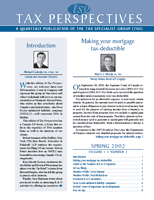
PDF Format
 Issue Contents Issue Contents
 All Issues All Issues
Spring 2002
Volume 1, Number 3
The information in Tax Perspectives is prepared for general interest only. Every effort has been made to ensure that the contents are accurate. However, professional advice should always be obtained before acting on the information herein.
Making Your Mortgage Tax-Deductible
By Kim Moody, CA, TEP
Moodys LLP Tax Advisors (Calgary)
On September 28, 2001, the Supreme Court of Canada released its long-awaited decisions in Ludco (2001 SCC 62) and Singleton (2001 SCC 61). Both cases involved the question of whether interest payments were tax-deductible. For interest to be an allowable expense, it must meet certain criteria. In general, the amount must be paid or payable pursuant to a legal obligation to pay interest on borrowed money that is used for the purpose of earning income from a business or property. Income from property does not include a capital gain earned from the sale of that property. Therefore, interest on borrowed money used to generate a capital gain will generally not be considered tax-deductible. Such a determination is always a question of fact. In response to the 1987 Bronfman Trust case, the Department of Finance released very detailed proposals for interest deductibility in a 1991 technical bill. These proposals, however, have been "on hold" for over 10 years while the Department has continued to study the issue. In the meantime, the treatment of interest deductibility has been in a state of flux. The Singleton and Ludco decisions move the issue of interest deductibility to the forefront once again. Mr. Singleton was a partner in a law firm. In 1998, he withdrew $300,000 of equity from the law firm to assist in the purchase of a personal residence. He then borrowed approximately $300,000 from a financial institution and invested the funds back into the law firm to replace the funds taken out. On his tax return, Mr. Singleton deducted the mortgage interest charged on this loan, reasoning that the borrowed money was used to earn income from a business (that is, his law practice). Revenue Canada (now the Canada Customs and Revenue Agency (CCRA)) disagreed with Mr. Singleton's reasoning and denied the interest expense deduction, saying that the borrowed money was used to finance the purchase of a house. The Supreme Court of Canada disagreed with the CCRA and suggested that it was an error to treat the transactions as one simultaneous transaction. To give effect to the legal relationships, the transactions must be viewed independently. Accordingly, the fact that the money was borrowed in order to allow Mr. Singleton to use his own funds to purchase the house was irrelevant. The court found that, in giving effect to the legal relationships underlying the transactions, it was obvious that the borrowed money was used directly to refinance the capital account in the law firm. This was a direct, eligible use of borrowed money. Accordingly, Mr. Singleton was entitled to deduct the interest expense. In both Singleton and Ludco, the Supreme Court of Canada reviewed the four elements that must be present before interest can be deducted. They are: - the interest must be paid in the year or be payable in respect of the year in which it is to be deducted;
- the amount must be paid pursuant to a legal obligation to pay interest on borrowed money;
- the borrowed money must be used for the purpose of earning income from a business or property; and
- the amount must be reasonable as assessed by reference to the first three requirements.
The court also suggested in Ludco that in order to meet these conditions, there must be a "reasonable expectation of income." The court further reasoned that "income" means income subject to tax and not net income. These decisions clearly indicate that there is scope to plan one's affairs to make interest deductible, even on a home mortgage. Such planning can replicate that of Singleton. All one needs is to have capital employed in an income-earning activity such as a business, a professional partnership, or an investment portfolio. Then, follow these steps: - Create liquidity by borrowing from the business or the partnership or by liquidating the investments.
- Use the funds to pay off your personal mortgage.
- Borrow using your residence as security (that is, negotiate a new mortgage) and put the funds back into the income-earning activity.
Before entering into such transactions, we encourage you to seek professional tax advice to ensure that such a plan is appropriate for you and consistent with your overall financial planning objectives. TSG representatives welcome the opportunity to determine whether you can make your mortgage tax-deductible.
|